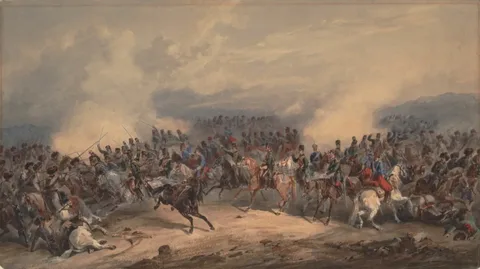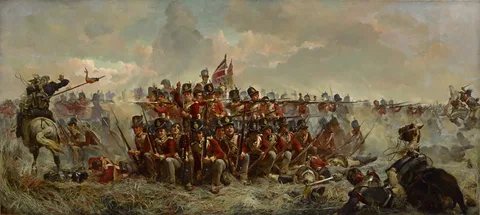The Battle of The Qird, fought in the 6th year of Hijri (approximately 627 CE), is an important yet somewhat less frequently discussed military engagement in early Islamic history. It took place during a formative period when the nascent Muslim community under the leadership of the Prophet Muhammad (peace be upon him) was consolidating its position in the Arabian Peninsula amid conflicts with opposing tribes and the Quraysh of Mecca. The battle holds significance as part of the ongoing struggle between early Muslims and their adversaries, marked by both strategic maneuvers and the solidification of the Muslim militia’s military confidence.
The Battle of The Qird

By 6 Hijri, the Muslims had been enduring a series of conflicts following their migration (Hijrah) to Medina. The Battle of Badr (2 Hijri) and the Battle of Uhud (3 Hijri) had already set the tone for confrontations between Muslims and the Quraysh tribal coalition. Subsequently, the Battle of the Trench (5 Hijri) had demonstrated the community’s resilience against siege and greater hostilities.
The Battle of The Qird occurred in this milieu of conflict escalation. It was part of the broader efforts led by the Prophet Muhammad to neutralize surrounding hostile tribes and secure Medina’s frontiers. This included expeditions and occasional direct confrontations with tribes allied with the Quraysh or other local enemies.
Exact details of The Battle of The Qird are sometimes overlapped or confused with other skirmishes and battles around the same time, but it is generally recognized as a decisive engagement against a tribe that posed a threat to the Muslims’ growing political and military presence.
The Combatants
The battle involved Muslim forces commanded by trusted leaders appointed by the Prophet, often involving the Muhajirun (emigrants from Mecca) and the Ansar (helpers from Medina). Adversaries were typically local tribes who opposed the Islamic message or were allied with the Meccan Quraysh to challenge the Muslim community.
This conflict was smaller in scale compared to major battles like Badr or Uhud but was equally crucial in weakening hostile elements and extending the influence of the Islamic state.
Read more: The battle of Bani Qaenaqaa’ (2 Hijri)
Events of the Battle
Historical records indicate that the Battle of The Qird was marked by tactical maneuvering and strategic use of the Muslim forces’ cohesion and motivation. The Muslim army utilized the familiarity with desert terrain and swift cavalry tactics.
The engagement involved a surprise attack or preemptive strike on the tribe in question, usually aiming to halt planned raids or attacks by the enemy against Medina or Muslim caravans. The Muslims’ successes were not merely due to military strength but also the growing unity and morale inspired by faith and effective leadership.
The battle ended with a Muslim victory, which further deterred hostile tribal alliances from launching attacks. This victory helped in consolidating Muslim control and securing supply routes necessary for the community’s survival and growth.
Read aout: The battle of That Al-Reqaa’ (4 Hijri)
Significance and Aftermath
The Battle of The Qird was pivotal for several reasons:
-
It showcased the strategic evolution of the Muslim military, which began to adopt not only defensive but proactive postures to secure their interests.
-
It weakened key adversaries and sent a clear message to tribes contemplating opposition to the Muslims.
-
The victory contributed to the ongoing process of unification of Arabian tribes under Islam, either through alliances, treaties, or military pressure.
-
It paved the way for greater political and social stability within Medina and surrounding regions.
The battle’s success fit into the series of campaigns and diplomatic efforts that would eventually lead to the peaceful conquest of Mecca in 8 Hijri and the spread of Islam throughout the Arabian Peninsula.
Recommend: The battle of the Amr (3 Hijri)
FAQs
What was the Battle of The Qird about?
The Battle of The Qird was a military confrontation in 6 Hijri between Muslim forces and a hostile Arabian tribe. It aimed to curb threats against Medina and Muslim caravans, resulting in a Muslim victory that strengthened their regional position.
Who were the main leaders in the Battle of The Qird?
Specific names of commanders vary in historical records, but generally, the Muslim forces were led by trusted companions of the Prophet Muhammad who had experience in previous battles. The Prophet himself would have authorized the operation.
How did the battle impact the Muslim community?
The victory enhanced the security of Medina, deterred enemy tribes, solidified alliances, and increased the military and political stature of the Muslims in the Arabian Peninsula.
Was this battle larger or smaller than other Islamic battles?
The Battle of The Qird was smaller in scale compared to major battles like Badr or Uhud but was significant strategically and symbolically in the context of ongoing regional conflicts.
What role did terrain and tactics play in the battle?
Familiarity with desert terrain and mobile cavalry tactics helped Muslim forces execute swift and effective operations against their opponents, highlighting their growing military capability and strategic planning.
Conclusion
The Battle of The Qird in 6 Hijri was a significant event within the early Islamic military campaigns. Although it was not as large as some other battles, its impact was substantial in solidifying the position of the Muslim community in Medina, weakening hostile tribes, and demonstrating the tactical and strategic maturation of Muslim forces. This battle contributed to the broader narrative of Islamic expansion, resilience, and state-building during the Prophet Muhammad’s time. Understanding such battles helps illuminate the complex dynamics and struggles faced by early Muslims as they navigated hostile environments and emerged victorious through faith, leadership, and unity.

